
Yuletide Yardsticks: The development and headaches of the PY system
by Dougal Henshall 24 Dec 2014 16:36 GMT
24 December 2014
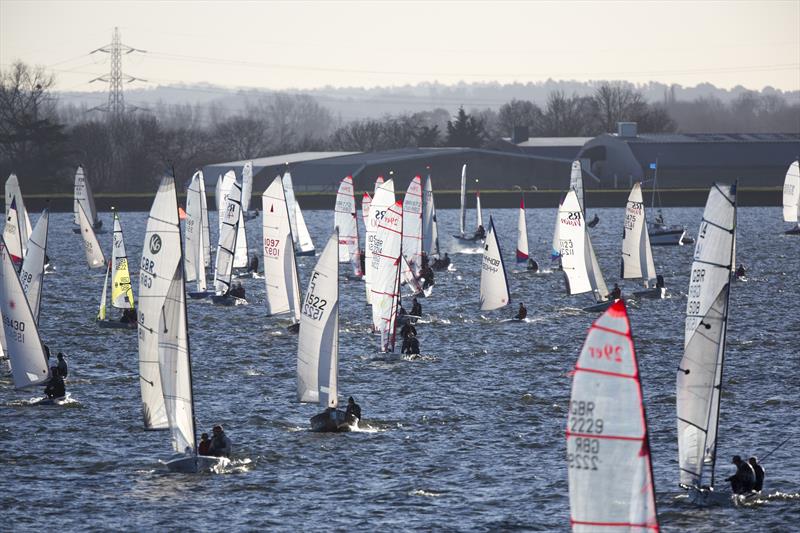
Bloody Mary 2014 © Alex Irwin /
www.sportography.tv
If we take the end of WW2 and the launch of the Merlin (Rocket) as a good starting point, then next year will see the 'modern dinghy' celebrating its 70th birthday. In terms of age, the Merlin wins the 'first to the bus pass' race against the Firefly by a matter of months, and only then because Jack Holt and Beecher Moore risked being OCS in a big way by restarting boat building before the hostilities had finally ceased.
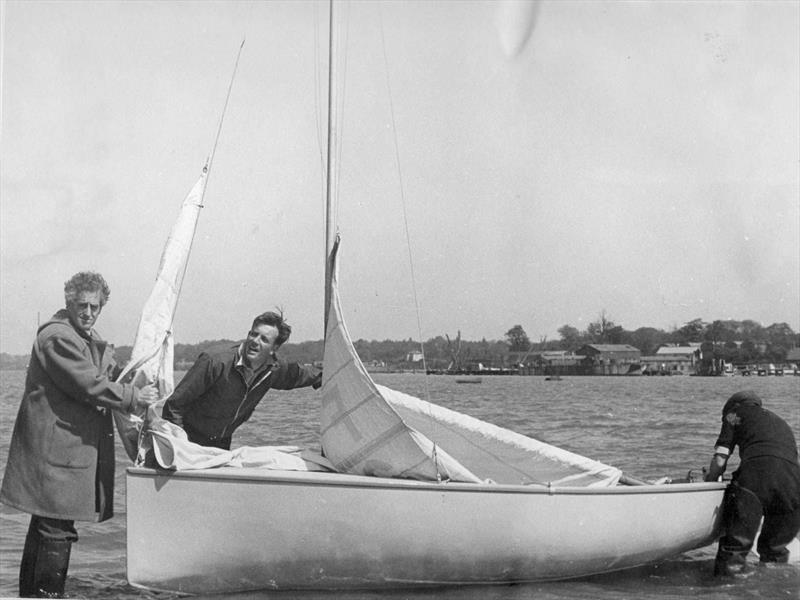
When Uffa Fox, crewed by Charles Currey, first launched the Fairey Firefly, it was not just the Hamble River, covered in barbed wire and gun emplacements, that was very different. Back then, apart from the National 12s, there was nothing to compare with the Firefly, which can be seen as a SMOD a full 25 years before other boats started to follow suit - photo © Fairey Marine / Currey Family
Still, it is very hard for us now, from the perspective of today, to look back to that era and the small number of boats that were the starting point for the boom in dinghy sailing, the 14s, 12s, Merlins and Fireflys. Interestingly, when in 1946 the Merlin was launched, the Yacht Racing Association (the YRA, soon to be rebranded as the RYA) tried to counter the initiative, arguing that the new boat would dilute the International 14 class and to a certain extent, the "younger and more virile" National 12.
Of course, as we now know, the Merlin was just the starting point, as Jack Holt, with his easy to build, fun to sail range of designs, helped usher in a revolution in the sport. With the guidance of Yachting World Editor Teddy Haylock and the commercial clout of Bell Woodworking, boats such as the Cadet, which tapped into the 'new' youth market; the wonderful all purpose GP14; the lightweight flyer that became the Hornet and then the Enterprise and Solo all fuelled an explosion in boat ownership and participation. Just as Holt had been the master of sheet ply construction, Ian Proctor would show how the new materials of GRP could make equally exciting boats, with his Kestrel being just one example of how the 'impersonal' plastic could make a very attractive and successful dinghy.
These though were just the headline designers who were leading the field, as the market was all but swamped with new dinghies of all shapes and sizes. Some, such as the Albacore, which itself was a spin off from the earlier Uffa Fox designed big brother to the Firefly, the Swordfish, would go on from strength to strength and become part of the core dinghy scene. Others, such as Trevor Kirby's Wineglass would enjoy a shorter period of popularity, before like the Herbert designed Seafly and Seafire, they all faded away.

Like its big brother, the 505, that helped inspire the hull shape, in the right conditions the Wineglass could be a very quick performer on handicap. Yet it only occupied a small niche in the market and when better boats came along, it was unable to retain its place and faded from the scene - photo © Dougal Henshall
But as the number of classes blossomed, so the need for a platform that would enable the many disparate classes to sail together became ever more important. The answer lay in the increasing development of what were becoming known as the Langstone Tables, a handicapping scheme that was very much the brainchild of Sidney 'Sinbad' Milledge. He devised a very simple solution to an otherwise highly complex problem with his 'Portsmouth Yardstick Tables', where boat designs were issued with a specific handicap number. With this system, racing could be conducted through an easily calculated 'corrected time', which was just a simple function of actual elapsed time and the yardstick number. A faster design of boat would, in theory, take less time to complete the course; a slower design of boat would take longer. The post race application of the Portsmouth Yardstick number to these two boats, if both were sailed in an identical fashion, would result in the same corrected time; conversely, a well sailed slower boat would out perform its handicap and would end up with a better corrected time than a poorly sailed but faster handicapped design. To keep the data in the tables up to date, the idea was that at the end of each sailing season, clubs would file a return on paper, giving details of how boats had performed across the year, so that in theory, at least the core Yardstick numbers could change to reflect increases (or decreases) in relative performance.
Amazingly, this system worked! Across the country, handicap racing became one of the main building blocks at many of the smaller sailing clubs, where there was never the 'critical mass' of any one class of boat to make up a viable fleet. With the numbers of new boats being built each year numbering well into the thousands, there was plenty of choice for sailors; those that wanted quality class racing could easily find it at another club nearby (or could work to build up their own fleet, through the efforts of 'fleet captains') whilst the less keen could happily enjoy their sailing at their home club. The key word in all of this was 'enjoy', for the majority of sailors appeared to be happy at the level they chose; those who sailed in the handicap fleet understood the imperfections implicit in the system and knew that if they wanted something better, then to stop moaning and get moving. But this also begs the question "did the system work better back then"?
The answer has to be the classic 'yes and no'. The 'no' is easily explained, in that the core operation of the system was the same then as it is now. Moreover, the key factors that underpin handicap racing, the Yardstick numbers assigned to various classes, remained almost static year on year. This resulted in some undoubted and well publicised anomalies, as those classes where development and competition was the hottest, ended up being the accepted best performers under handicap racing conditions. It became widely understood that boats such as the Enterprise and 505 were two of the best performers on handicap, for as yet, the development boats had yet to really make a significant impact on the PY scene.

Breezy conditions like this were never the forte of the Enterprise, but on a day of light, fluky zephyrs, the boat was - and can still be - a devastatingly quick performer on PY - photo © Paul Manning
But it is the 'yes' side of the answer that is more revealing in the light of what we would like to think of handicap sailing today. However, the answers are fairly complex and range over many different facets of the sport. Probably though the biggest differences back in the 1960s and 1970s was the reduced spread in term of PY range within the fleet and the skill levels of the helms. The two fastest dinghies in terms of handicap number were the Flying Dutchman and International Canoe (which sailed off the same rating) but these two boats were hardly regular attendees in the handicap fleet. Nor was the catamaran fleet anywhere near as developed as it would be just 20 years later and anyway, the accepted wisdom back then was that cats and dinghies didn't mix well in the same race. It was left to the 505 to be the 'scratch boat' (or top dog, a much better description) at most PY events, a role that the boat excelled at. The undoubted ability of the 505 to ghost along better than most in the light stuff, yet be able to blast away from the competition as soon as the wind kicked in, made the boat into something of a handicap handful, as well as having the advantage of top class championship level sailing for those who wanted it.

The Author, crewing for David Pitman in the 505, winning a light and shifty Tilly's Tiller at Queen Mary Sailing Club. A fortnight later, in a gusty F6 and full on blizzard conditions, the pair proved the all round winning credentials of the 505 by also winning the Burnham Icicle. These were the glory days for the 505, when they regularly featured at the front of the fast handicap fleet - photo ©
Banks Sails
For the rest though, the massed ranks of boats from the Fireball and Hornet, through the Albacore, Enterprise and GP14 all seemed to be able to happily co-exist together; if it blew, the trapeze boats had a field day, in the light stuff the Enterprises and GPs could hang on to the transoms of the faster boats well enough to comfortably win on corrected time.
So what happened? At the peak of the dinghy boom, with new designs of boat being launched on an annual basis, it was clear that a greater granularity was needed. In addition, the growing strength of the catamaran scene meant that the scope of the PY scheme needed to be extended to accommodate boats with a far lower PY rating. The Handicap numbers were all subjected to a multiplication, then a second running of the exercise, with the result that the Firefly (which had always been seen as the mid-point in the number range with a PY Yardstick of 100) now found that it was rated at 1162. Of course, this actually meant very little as all the other classes had kept their relative positions with their own change. This alone though would not have accounted for the far more fundamental change that was starting to sweep through the sport.

If the PY system of old had started to struggle with the extended range of the numbers, courtesy of the explosion in cat sailing, it now had to cope with the arrival of the foiling International Moth, which at Hayling Island now races of a PY of 499! - photo © Craig Greenhill / Saltwater Images
Depending on the individual perspective, the causes of the 'tipping point' – the time when growth in the sport slowed, became static, before heading into decline are multitudinous and varied. Some will point to the windsurfing revolution, others the arrival of the Laser. The more thoughtful may well point to the changes in the socio-economic make up of the sailing population in the light of two major and very deep recessions in less than eight years. With UK unemployment peaking at over 10% of the workforce, dinghy sailing (which had been outpacing even the rocketing levels of inflation) suddenly started to look like an expensive luxury. Like the dinosaurs before them, for the first time the sport saw something of a mass extinction, as classes failed to adapt. It is though one of the clear observations that the great impetus for changes in dinghy development tend to come as the mainstream economy emerges out of recession. This was certainly the case in the early 1990s, as after yet another deep recession, dinghy development came back with a bang and a whole range of new boats.
The Laser 5000, Topper's ISO (followed by the Boss and Buzz) and then the RS400 changed the nature of club sailing overnight.
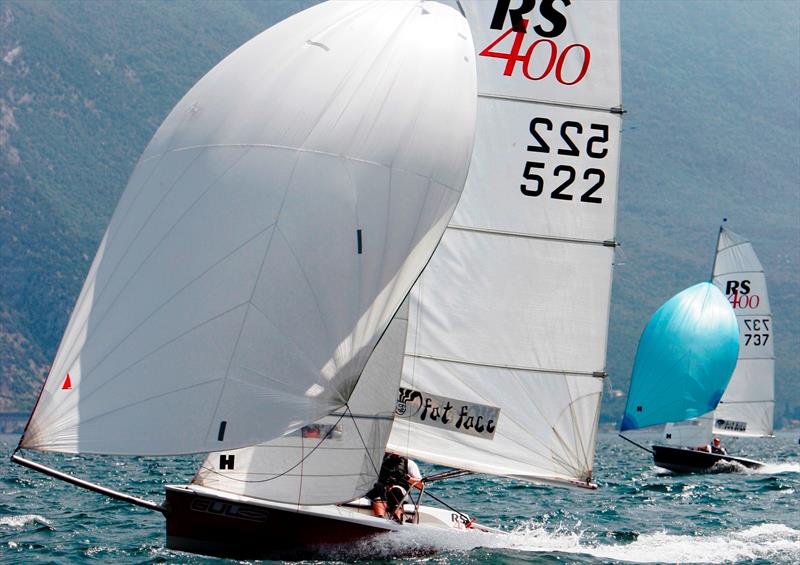
With a healthy infusion of Merlin Rocket DNA and a bang up to date rig, the RS400 would confound the critics and become a great boat for round the cans racing. If there is a problem with the boat it could be that it is almost TOO quick, as its yardstick positions it as fast around a course as many of the top trapeze rigged boats - photo ©
RS Sailing
But, at the same time, the PY system suddenly found that it was coming under pressure, for apparently failing to accommodate the new boats. As the sport had started to contract, more and more clubs found that they were losing their core one design fleets at the expense of a larger handicap fleet and it was into this mix that the new asymmetrics classes were catapulted. Of course, what was really happening was all to do with....the course! The new boats didn't really like 'round the cans racing' which was where the majority of handicap sailing was taking place. They did however excel at sailing on windward/leeward courses, but all too often these were at the expense of the other dinghies. It was a problem that Racing Committees at clubs around the country struggled with and all too often failed to address. The obvious solution, of setting a w/l course for the asymmetrics and a trip around the cans for the rest, simply risked a further fragmentation of the racing, with sub-optimal size fleets for all.
The problem was then compounded further by the disparity in the ages of the boats and rigs in the diverging fleets. The new asymmetrics were coming out with well-considered, up to date rigs, yet increasingly the bulk of the handicap fleet was being made up of boats that were already more than a few years old. Now it is not the job of a PY system to take into account the lack of race quality, but at the same time well equipped but older boats where facing other and more daunting challenges. For many years, back through the 'golden era' of dinghy racing, the development classes had quietly done their own thing. But not any longer, as a period of rapid and radical change was about to change the very nature of the boats and their sailing. Nowhere was this more apparent than in the International Moth, which just a few years earlier had been based on a hull shape not that different to any other 11ft dinghy. Handicap wise, the Moths were hardly a feature of note, with their PY showing them significantly slower than a Firefly. In less than a decade, they were quicker than a Fireball and in the right conditions, faster through the water in a straight line than a 505.
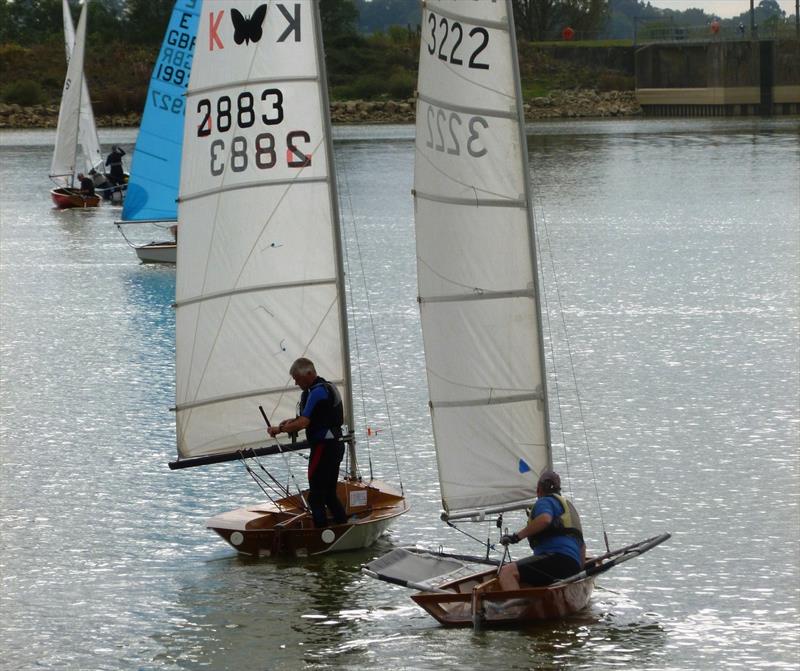
Who would be a club handicapper? In just a couple of seasons, the International Moth went from looking like a small conventional boat, with a PY that positioned it firmly in the Slow handicap fleet, to a boat capable of beating a Fireball around a course – on the water - photo © Dougal Henshall
For the RYA, tasked with operating the PY system, the Moth, which was quickly developing a well-justified reputation for running away with handicap events, was just one part of a bigger problem. The RYA already had their hands full trying to make sense of the changes in the Merlin Rocket and how these should be handled. The Merlin PY had remained fairly static for a number of years in which the boats from Phil Morrison and Keith Callaghan had developed into a superbly adapted club racer. In this respect, the Merlin Rocket had even supplanted the 505 as the 'club racer par excellence', but things were changing fast in the world of Merlin Rocket design. First came a new ground breaking design, the Canterbury Tales, which also brought with it a return to deck-stepped masts that could be easily raked. Like the new breed of Moths, the new Merlin Rockets offered that rarity in dinghy racing, a step function upwards in performance, one that the RYA could no longer ignore. After the extended period of stability, the decision by the RYA to cut the PY for the class from 109 to 107 caught many by surprise. For the new breed of boats the change was wholly justified and some would have said that it still left the boats with an unfairly favourable handicap.

Add a winning design, the Canterbury Tales, to an improved build technique with an FRP hull, a deck stepped, raking mast and a top class builder and the result is a step function forward in performance. Then, add in the combined skill sets of a superbly focused and highly talented helm and crew and the Championship winning potential is obvious. Yet as other crews followed the example set by Phil and Jennie King with their boat Savage, the 'old' PY that the class had enjoyed would be cut - then cut again - photo © Nigel Brooke
But for the rest of the Merlin Rocket fleet, the change presaged a handicap disaster, as boats suddenly needed to be 80 seconds in an hour faster just to remain competitive. The answer of course was that they could not and when the RYA slashed the handicap a second time, it was effectively curtains for a whole generation of boats. The Merlin Class Association were aware of the problem and suggested an arbitrary break point, with two differing PYs for the class, one old, one new, but this just made matters worse. There were just too many older boats that were just the wrong side of the dividing line for this to work and beside, for the new boats, the majority of which were sailed on the open meeting circuit, the issue was merely academic. In the end, nothing further happened and further initiatives were dropped until a layered handicap system was introduced for the classic boats. This detailed examination of the Merlin Rocket scenario has been included for a purpose and will be referred back to later in the article.
Handicaps were now coming under further pressure, across the sport, thanks in no small part to the revolution that had taken place in the quality and easy availability of 'fit for purpose' all weather clothing. Traditionally, the period between the New Year and Easter (or between the 'laying up' supper and the 'fitting out' party) were the quiet months. For the sailors who really were oblivious to the weather, there were events like the Bloody Mary, Burnham Icicle and Pompey Perisher, but these had, by tradition, been events for the really hardy souls. Now, winter events blossomed all across the country, from the 'Beastie' at Wimbleball in the West to Grafham's Grand Prix in the East, the sailing calendar was now full with high profile events that numerically were amongst the largest dinghy gatherings of the year – and they were all sailed on handicap. This presented a whole new range of issues for the organisers, as the high level of 'desirability' for success in the events saw them attracting the cream of the UK sailing scene. With top sailors in top boats, top sailors in new and sometimes experimental boats, the capabilities of the PY system were tested as never before.
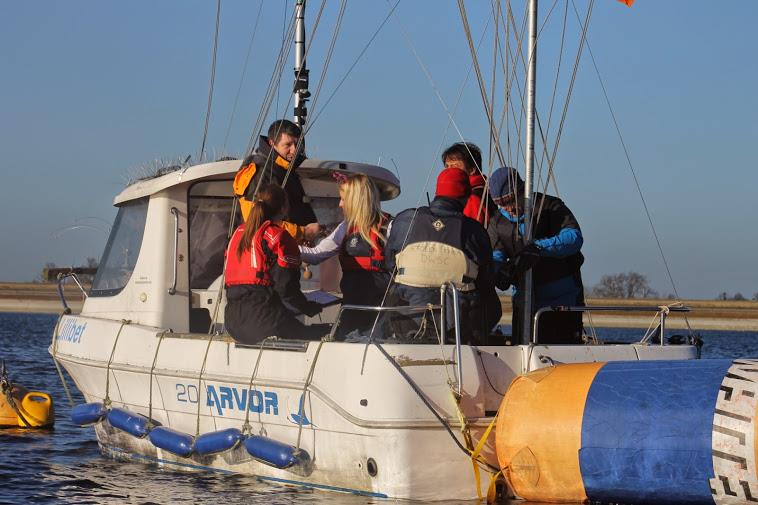
The new breed of winter events set a challenge for the Race Teams as much as the PY system itself. With a large number of entrants for events such as the Datchet Flyer, with boats rounding at different speeds, lap recording demands a greater level of management than ever before. Luckily, the use of GPS trackers on boats can not only aid the on water Race Teams, but provide a great deal of valuable data that can assist the sailor in his post race assessment (not to mention event organisers when setting PYs in subsequent years) - photo © SailRacer
However, other developments were also starting to change the way the whole structure of handicap racing was being managed. We had been promised since the early 1960s that the "white hot heat of technology" would radically alter our lives, freeing us from so much of the hum drum routine. It might have taken almost 50 years to reach the world of dinghy racing, but at long last, the ubiquitous use of computers brought their power to bear on the task of calculating corrected times in a dinghy race. For a while there were any number of competing programmes developed by various sailing clubs and organisations, before Colin Jenkins developed his user-friendly Sailwave platform, which in time would emerged as the first market leader. Not only did Sailwave do the basic number crunching to work out the results of both the race and the series, it offered so much more in the way of functionality for those clubs willing to explore just how handicap racing could be improved upon.
It was of little surprise that the UK's leading dinghy club, Hayling Island, was amongst the first of the clubs to recognise the significant factor that tide could play in biasing handicap results. Building on their extensive experience in this field, they introduced a further layer of mathematical correction in the form of a tidal correction factor. The slower the boat, the greater the bonus it accrued from the tidal correction, whilst conversely the faster the boat, the greater the reduction in its PY number. However, the system used the RYA core PY numbers as a starting point, but the new levels of computerisation and connectivity were having an impact here too. It was now possible to upload sail results directly to the RYA, where they would be added to a rapidly growing store of data. Accepting that one of the key drivers of any statistical system is sample size, the RYA, through the PYAG (Portsmouth Yardstick Advisory Group) could now start to amend the yardstick for any given class based on a far greater understanding of how that boat was now performing. These changes would come as a rude shock to some classes that had enjoyed the benefits of updating and change and the lengthy time lag before that started appearing in their latest PY. Suddenly, yardsticks that had scarcely changed by more than a point or two were subjected to a number of consecutive years of significant step changes in their number. With the new numbers for the year now released the day before the Dinghy Show, you could tell at a glance what boat a sailor raced with Laser sailors wearing a smile, while Merlin Rocket and Phantom sailors could be seen crying into their beer whilst stood at the bar.
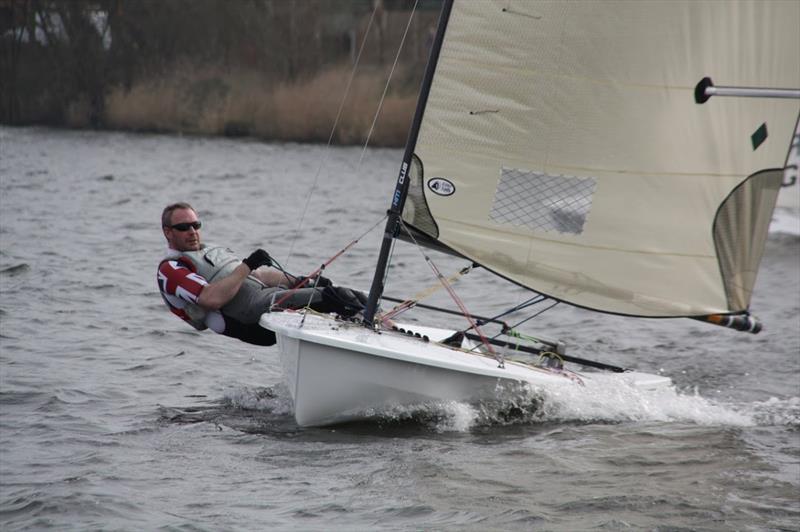
Thanks to the carbon raking rig and an FRP hull, the PY on the Phantom has had a number of significant revisions - photo © Paul Allen
However, the changes made by the RYA were more than mirrored by the combined clubs responsible for the top winter events, which now went under the name of the 'Great Lakes' circuit. In conjunction with Sail Racer, who were by now the leading specialists in the field of handicap management, the Great Lake Race Team were happy to make significant adjustments to the core RYA numbers, to the point that one of the popular 'favourites' for the series, the Merlin Rocket, found itself racing off the same number that the RYA awarded the Fireball.
In some ways the Great Lake Committee has it easy, for the strength in their argument lay in their name - 'Great Lakes'; meaning that their handicap changes did not have to encompass and performance out on open water courses at sea. This specialist list of figures has given rise to a considerable debate that may well suggest the next way forward in terms of handicap development. Once again, a reference back to the Merlin Rocket may well give clues to a viable solution. For over 60 years, the class has competed for the season long Silver Tiller Trophy, which has always demanded a winning capability across a range of conditions and venues. Today, the Silver Tiller circuit comprises events from 3 categories, with boats needing to include results from all three types of event. The 3 categories are Sea: Held out on the open sea, Open Water: Held on large inland stretches of water or estuaries and Restricted Water; Held on rivers and on the smaller inland lakes and reservoirs. There are many in the dinghy sailing world who are questioning if it is within the flexibility inherent in the PY system for three differing sets of PY numbers to be allocated, in addition to the 'core' RYA number, leaving clubs free to choose the option that best suits the prevailing conditions they sail on. However, taking that move away from the 'one size suits all' PY number per class seems anathema to a great number of people within many of the classes, but maybe their concerns are that once you accept change, it could spread further.
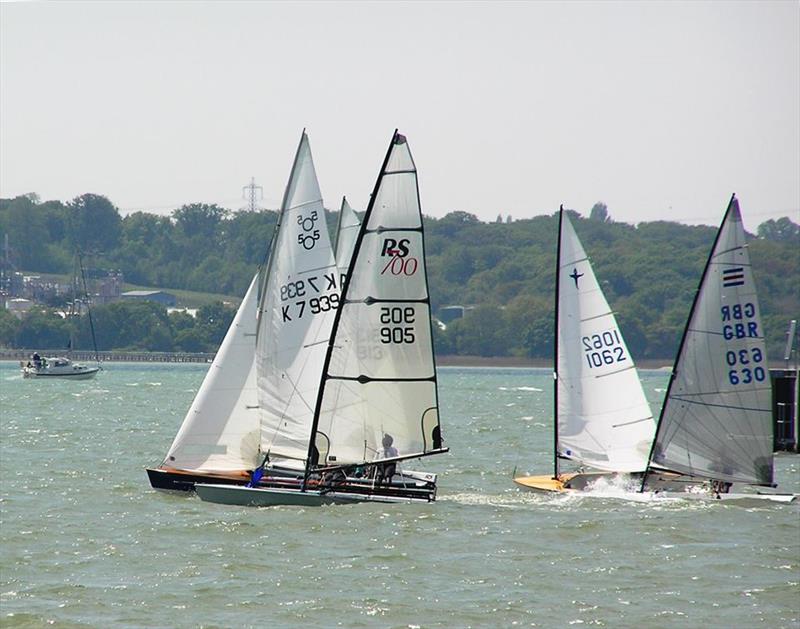
Being an old design does not make a great boat into a bad design. The 505 was always a great club racer and could be so again. There is no shortage of boats laid up in dinghy parks that with a little work could be back out on the race course showing their race winning pedigree. But to do this, the older boats will need some help; a middle aged lady such as this great Rowsell-Morrison 505 may be good, but cannot hope to sail to the PYs given to the latest breed of FRP wonder boats with maxi-monster spinnakers. At least the 505 Class are debating this topic; some classes where the subject is a non-starter may well regret their decision as numbers continue to leach away - photo © Susan Munroe
One way in which accepting that the core RYA PY number is just the starting point, is to accept that boats do age and that even those that are well maintained and using state of the art gear can struggle to compete. There are so many examples of this at work, but the 505 is one where there are clear 'cause and effects' at work. As was stated earlier, the 505 always used to be a great performer as the top level of club racing. Then, in an attempt to out perform the new breed of skiffs, the class adopted a new 'monster' sized spinnaker. On the big open water courses where championships are held this certainly turbo boosted the thrills of sailing the boat, but when racing around the cans, the big spinnaker was all too often unwieldy and impossible to carry on many of the reaches. A boat that had been amongst the best reaching machines to ever hit the race course suddenly found that it was moving into needing a w/l course to make the best of the new rig. Meanwhile that turbo boosting came at the expense of a hefty hit on the PY, which was fine for the elite crews on the large w/l courses, but was the kiss of death for most of the remaining boats racing at club level. Those that chose to sail with the smaller spinnaker found they could still make it around the cans, but suffered with the reduced sail area on the deeper legs. Rig the big kite and they had all the sail area they wanted, but could not use it; either way they were dead in the water on PY. The good news for the class is that with one eye on the prospect of hosting a classic event, as part of the upcoming Worlds at Weymouth in 2016, there is serious consideration being given to introducing an age related sliding scale of PY numbers, that could be just what is needed to restore some of the grassroots activity in the class.
One can but hope that this far-sighted approach is adopted elsewhere, for across the country dinghy parks are slowly filling up with good boats that are now slipping off the pace. In the old way of things, these boats would have been traded for a 'same but newer', but increasingly that is no longer the way of life. If you cannot compete, the incentive to get out and sail each and every weekend gets weaker.

There is now such a disparity in the performance of the Merlin Rocket class that sailing them all together in one single fleet, on a 'first past the post' basis, is in danger of alienating those boats outside of the modern FRP hull/carbon raking rig division. Yet there remains a huge potential for the class to bring the older boats back under the mainstream wing of the Class Association, rather than closing the door and referring them away to the classic scene - photo © Nigel Brooke
This whole question of 'incentive' can quickly get emotive; for example next year will see a celebration year for the Merlin Rockets and there has been some discussion about attracting a range of older boats to their Inland Championships, to be held at the beautiful location of Bristol Corinthian. Sadly, what could be such a great idea is looking likely to founder, due to the lack of any incentive being put in place to attract the older boats to the event. The answer that sailing a Merlin Rocket is incentive enough is just unrealistic in so many ways and ignores all the clear evidence, that in terms of sailing, the elite are getting faster whilst at the same time the rest are barely marking time.
But would location specific handicaps, tidal correction factors and age related adjustments really make a difference? For starters, it would do no harm and might just slow down, or even reverse some of the ground lost by the sport in recent years. As a plan, it makes a great deal more sense than some of the suggestions considered of late by our sailing authorities, which included a number of initiatives aimed at shoe-horning the dinghy racing population back into one design racing, like it or not. For those who did not want to comply, or preferred to sail the boat they loved or suited them and the local conditions, some of the 'blue sky' thinking went event further, suggesting that clubs reduce the opportunities to run handicap races and deny access to club social events for those in the PY fleet. Nor were many of our most successful, albeit 'traditional' classes spared; one design sailing should take place in "the new classes as they are better and faster".
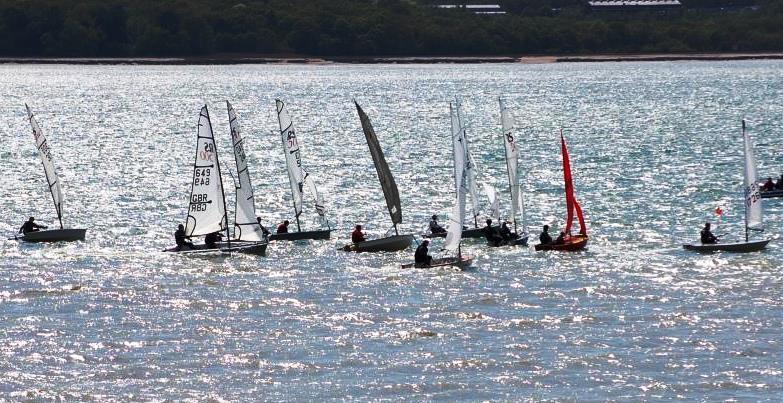
A Wednesday evening race at a popular South Coast club may look like the bill of lading for Noah's Ark (Just two of any given species – or classes!) but this is the reality of the grassroots sport. The idea that this could be replaced by single class racing is wonderful but, in the end, nothing more than idealistic thinking. This is the reality; it just needs to be made better! - photo © Dougal Henshall
No one would question that if dinghy racing, as a sport, was to be launched in the modern world, it would start out looking very different to the pursuit that has evolved over the last 70 or so years. Yet that 'blue sky' thinking suggests that, in the pursuit of excellence for the elite, the grassroots will again be side-lined. The harsh truth that underpins dinghy racing today is that the purist side of the sport, centred on a fewer number of boats, creating one design racing, has long gone, leaving the grassroots firmly rooted in the handicap scene. Rather than denigrate this, it should be embraced in the same way as other progressive events in life have changed society as a whole. There is a very wise old saying that suggests, "that any sin that cannot be cured should be instead declared a virtue", which is a pretty good description of how the handicap system should now be viewed. It means that if we are going to re-energise the sport, getting more boats back out sailing will inevitably mean even more races run under the handicap system. In that case, it clearly makes sense to make the most of the opportunities that exist, to look again at the handicap system and how it can be improved. From the use of GPS trackers to record hull speed at any given point of sailing, to advanced modelling techniques that can be focused right down to the specific requirements of an individual club, the handicap system can be made to work. For those that want it, one design racing does still exist, though it may take more than just conscious effort to enjoy it; you might have to travel too.
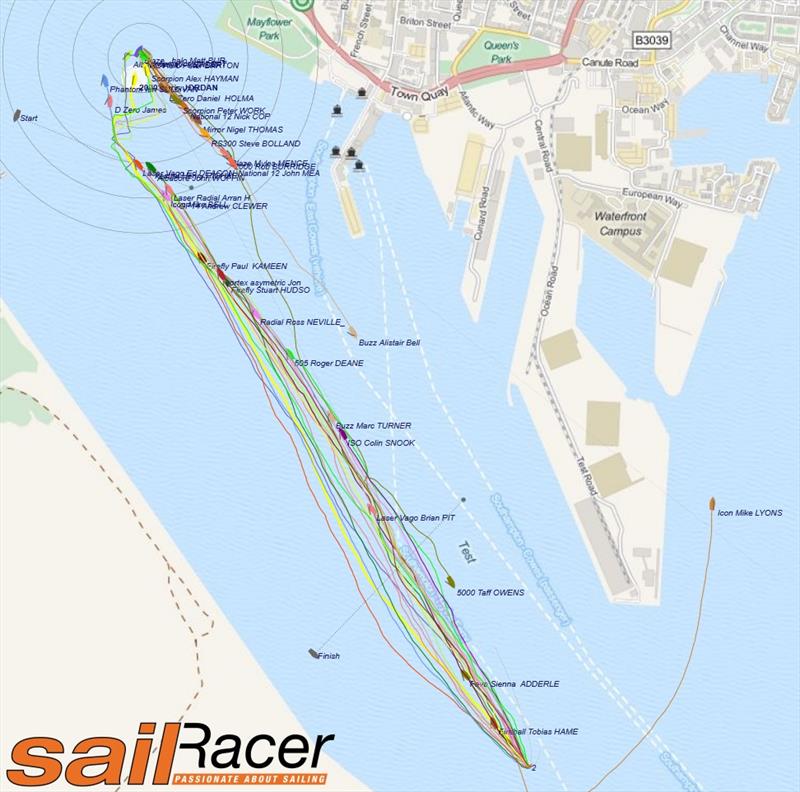
With this level of detail now being recorded, the challenge for the team at Sail Racer is to develop the tools to analyse the relative performance of any boat in a given situation and wind condition, then to look at how this could drive more meaningful handicap setting - photo © SailRacer
For, despite what the purists might argue, handicap races still have to be won; the sailor still has to be able to produce a winning performance. Would it not be better for the long term future of the sport, to have more people out afloat, with a return to more enjoyment in their racing, (even though it may be on handicap), than just continue this race to the bottom, which will ultimately result in a small elite, sailing boats that no one else can manage, whilst the rest of us search elsewhere to find other activities!
Happy Christmas!